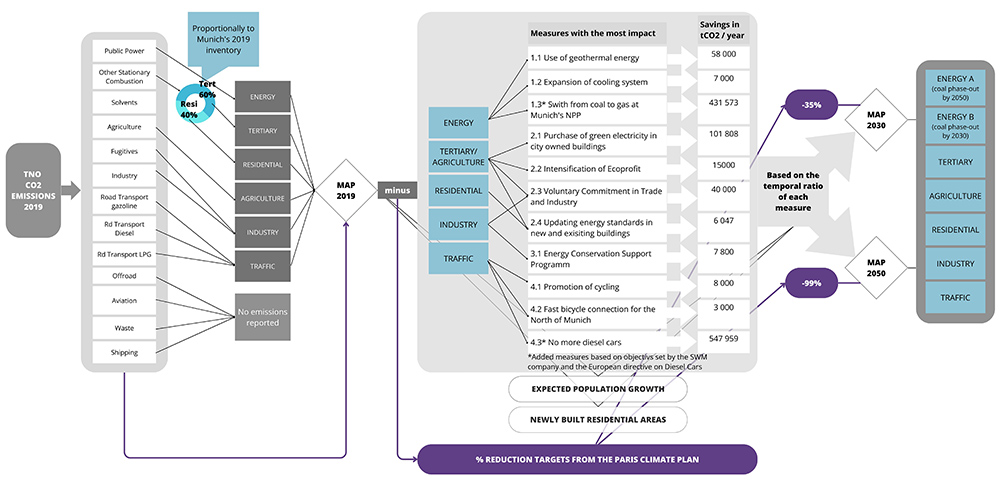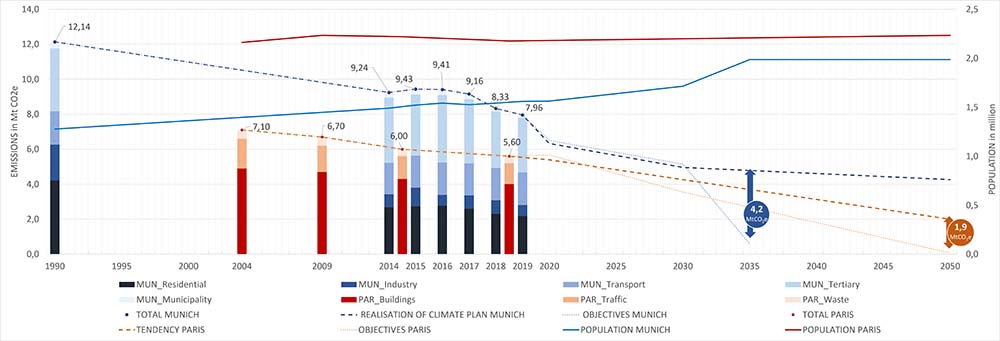A recently published ICOS Cities article demonstrates how climate action plans, carbon emission inventories, and urban development plans can help design optimal atmospheric monitoring networks.
ARTICLE: From political pledges to quantitative mapping of climate mitigation plans: Comparison of two European cities, in the journal Carbon Balance and Management
doi.org/10.1186/s13021-023-00236-y
AUTHOR: Ivonne Albarus is a junior researcher affiliated with France's renowned Laboratory of Climate and Environmental Sciences (LSCE) and the French start-up Origins.earth. Her PhD research focuses on the intersection of urban climate politics and atmospheric monitoring.

Paris and Munich display widely different emission trajectories in space and time, reflecting different emission reduction strategies and constraints due to administrative boundaries. The projected carbon emissions rely on future actions, hence uncertain, and we demonstrate how emission reductions vary significantly at the sub-city level. We did a Q&A with the author Ivonne Albarus to know more.
Q: What has been the main objective for your research project for ICOS Cities?
A: The key objective was to project city emissions between 2030 and 2050, by taking into account the mitigation actions mentioned in the city's climate action plans, as well as socio-economic evolutions. We also wanted to look at future scenarios, constraints and changes, in order to give long-lasting and long-impacting guidance to policy-maker decisions and research infrastructures.

Q: What were the key findings?
A: For now, we focused on the two ICOS Cities pilot cities, Munich and Paris. The two chosen cities serve as representative case studies, showcasing different levels of input data. For instance, Munich has a short-term climate action plan with detailed and quantified mitigation actions. In contrast, Paris focuses on a long-term perspective with only relative reduction targets and a more general approach. Despite these underlying differences, we showed that our method can be applied to different urban areas, enabling the assessment and comparison of various cities’ emission reduction strategies.
Our study demonstrates how climate action plans, carbon emission inventories, and urban development plans can be combined to construct high-resolution projected emissions maps to help design optimal atmospheric monitoring networks. We show that these two European cities display widely different trajectories in space and time, with significantly varying emission reductions at the sub-city level, reflecting their different emission reduction strategies and constraints due to administrative boundaries.
We conclude that quantified individual cities’ climate actions are essential to construct more robust emissions trajectories at the city scale. Also, harmonisation and compatibility of plans from various cities are necessary to make inter-comparisons of city climate targets possible. Furthermore, dense atmospheric networks extending beyond the city limits are needed to track emission trends over the coming decades.

corresponding emission targets.
Q: What does this imply in regards of the key objectives of the ICOS Cities project?
A: Our results confirmed the need for harmonisation and compatibility of climate action plans and inventories to effectively make inter-comparisons of city climate targets and emissions trajectories. The integration of urban development plans is crucial since it changes the land usage. Where we might have agricultural land today will be residential areas in the future, and future atmospheric monitoring networks need to take those planned changes into account.

Q: Will the research project continue somehow?
A: Yes. For example, in the Paris Climate Plan the mitigation actions are not quantified, in contrast to Munich, and only relative targets are mentioned (e.g. a reduction of local emissions of 50 % by 2030, compared to 2004). We are currently working on quantifying those mitigation actions in order to see the spatial implication of the high-resolution projected emissions.